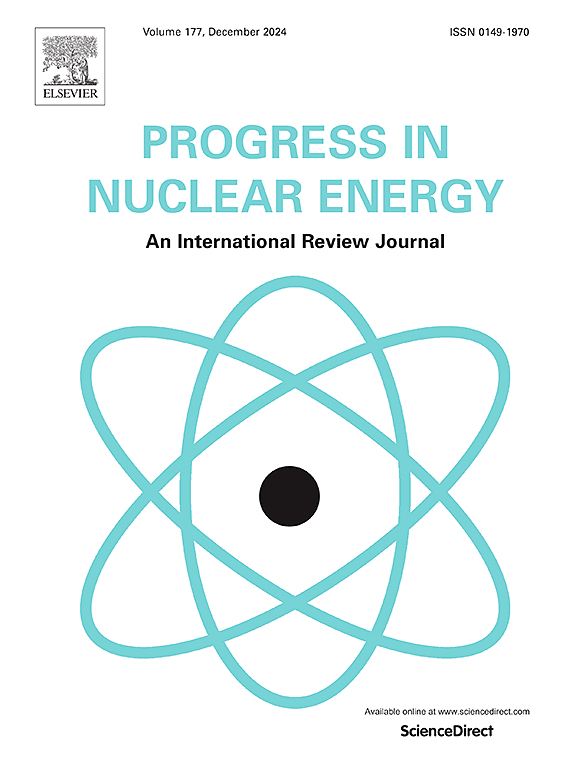Experimental study and analysis of swirling flow regime transition and separation performance for a new cycloidal vane separator at high gas-liquid velocity ratios
IF 3.3
3区 工程技术
Q1 NUCLEAR SCIENCE & TECHNOLOGY
引用次数: 0
Abstract
This paper systematically investigates the flow characteristics, separation performance, and pressure drop behaviour of an axial cycloidal-profiled swirl vane separator under low-humidity conditions for small modular reactors. Through comprehensive experiments on a self-designed test platform, covering three drainage heights (300/400/500 mm) and five liquid flow rates (18–41.4 kg/h), the critical transition boundary from swirling annular flow to churn flow under low Reynolds numbers was revealed to exhibit linear growth characteristics, while existing theoretical models significantly overpredicted values in this operational range. In stable swirling annular flow regimes, the separation ratio (η) gradually decreases due to secondary droplet breakup. Flow regime transition triggers a sharp decline when liquid holdup (ϕ) exceeds the critical threshold (ϕcri). Increasing drainage height reduces ϕcri by approximately 10.2 % and narrows the stable operational window. Sobol global sensitivity analysis identifies liquid superficial velocity (Ul) as the dominant parameter influencing η, with dimensionless drainage height indirectly affecting η through coupling with gas velocity (Ug). ΔP exhibits a strong linear correlation with gas superficial velocity, and a localized “negative growth” phenomenon occurs at low Ug due to liquid film backflow. Non-gravitational pressure drop gradient ((dP/dL)f+a) increases linearly with the gas-liquid velocity ratio, while a higher liquid flow rate elevates the pressure drop gradient. The proposed regression model validated the negative effect of H∗ and the interaction effect of gas-liquid shear effects and liquid film inertia on (dP/dL)f+a.
高气液速度比下新型摆线叶片分离器旋流型转换及分离性能的实验研究与分析
本文系统地研究了小型模块化反应器在低湿条件下轴向摆线型旋流叶片分离器的流动特性、分离性能和压降特性。在自行设计的试验平台上进行了3种排水高度(300/400/500 mm)、5种液体流速(18-41.4 kg/h)的综合实验,揭示了低雷诺数下旋转环空流到搅拌流的临界过渡边界呈现线性增长特征,而现有理论模型在该工作范围内存在明显的高估。在稳定的旋流环空流动状态下,由于二次液滴破碎,分离比(η)逐渐减小。当液含率(ϕ)超过临界阈值(ϕ)时,流态转换触发急剧下降。增加排水高度可减少约10.2%的ϕcri,并缩小稳定的操作窗口。Sobol全局灵敏度分析表明,液表速度(Ul)是影响η的主要参数,无量纲排水高度通过与气速(Ug)的耦合作用间接影响η。ΔP与气体表面速度呈较强的线性相关,在低Ug时由于液膜回流,出现局部“负增长”现象。非重力压降梯度(dP/dL)f+a)随着气液速度比的增大而线性增大,而液体流量越大,压降梯度越大。所建立的回归模型验证了H *的负作用以及气液剪切效应和液膜惯性对(dP/dL)f+a的交互作用。
本文章由计算机程序翻译,如有差异,请以英文原文为准。
求助全文
约1分钟内获得全文
求助全文
来源期刊

Progress in Nuclear Energy
工程技术-核科学技术
CiteScore
5.30
自引率
14.80%
发文量
331
审稿时长
3.5 months
期刊介绍:
Progress in Nuclear Energy is an international review journal covering all aspects of nuclear science and engineering. In keeping with the maturity of nuclear power, articles on safety, siting and environmental problems are encouraged, as are those associated with economics and fuel management. However, basic physics and engineering will remain an important aspect of the editorial policy. Articles published are either of a review nature or present new material in more depth. They are aimed at researchers and technically-oriented managers working in the nuclear energy field.
Please note the following:
1) PNE seeks high quality research papers which are medium to long in length. Short research papers should be submitted to the journal Annals in Nuclear Energy.
2) PNE reserves the right to reject papers which are based solely on routine application of computer codes used to produce reactor designs or explain existing reactor phenomena. Such papers, although worthy, are best left as laboratory reports whereas Progress in Nuclear Energy seeks papers of originality, which are archival in nature, in the fields of mathematical and experimental nuclear technology, including fission, fusion (blanket physics, radiation damage), safety, materials aspects, economics, etc.
3) Review papers, which may occasionally be invited, are particularly sought by the journal in these fields.
 求助内容:
求助内容: 应助结果提醒方式:
应助结果提醒方式:


